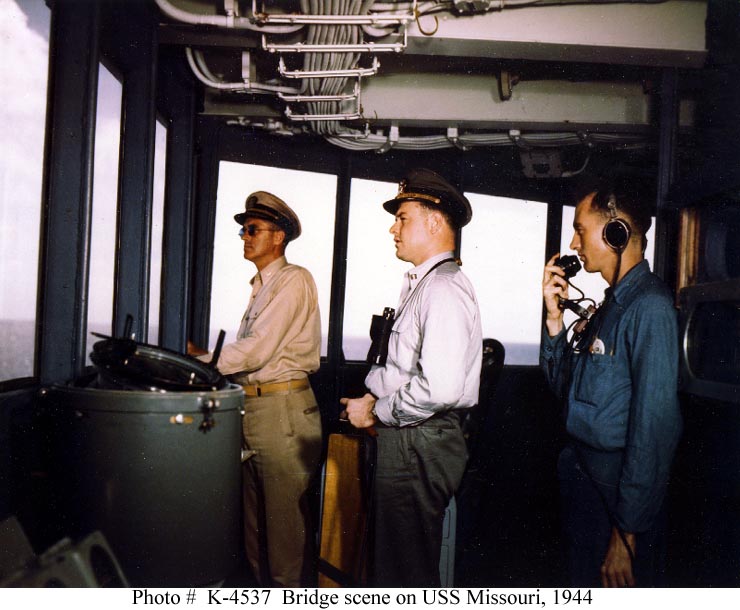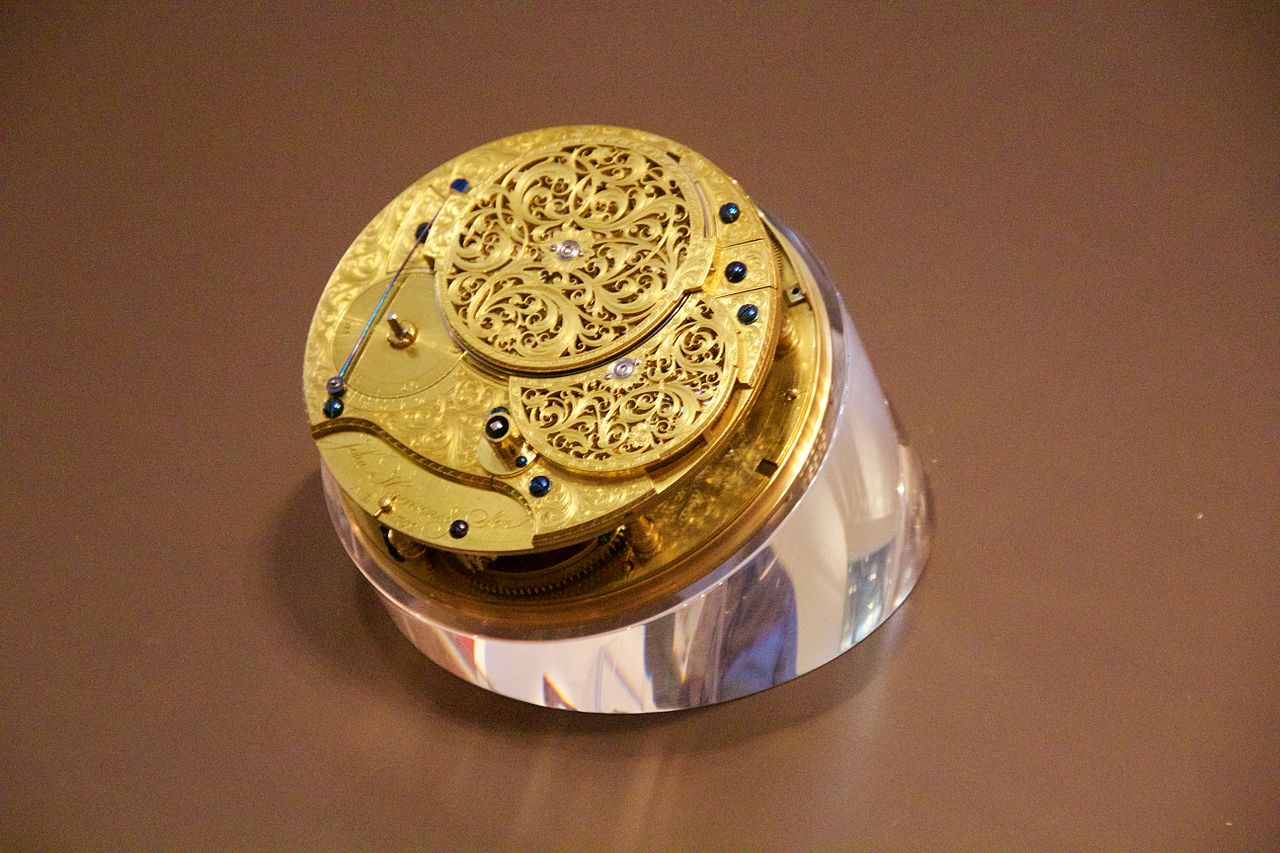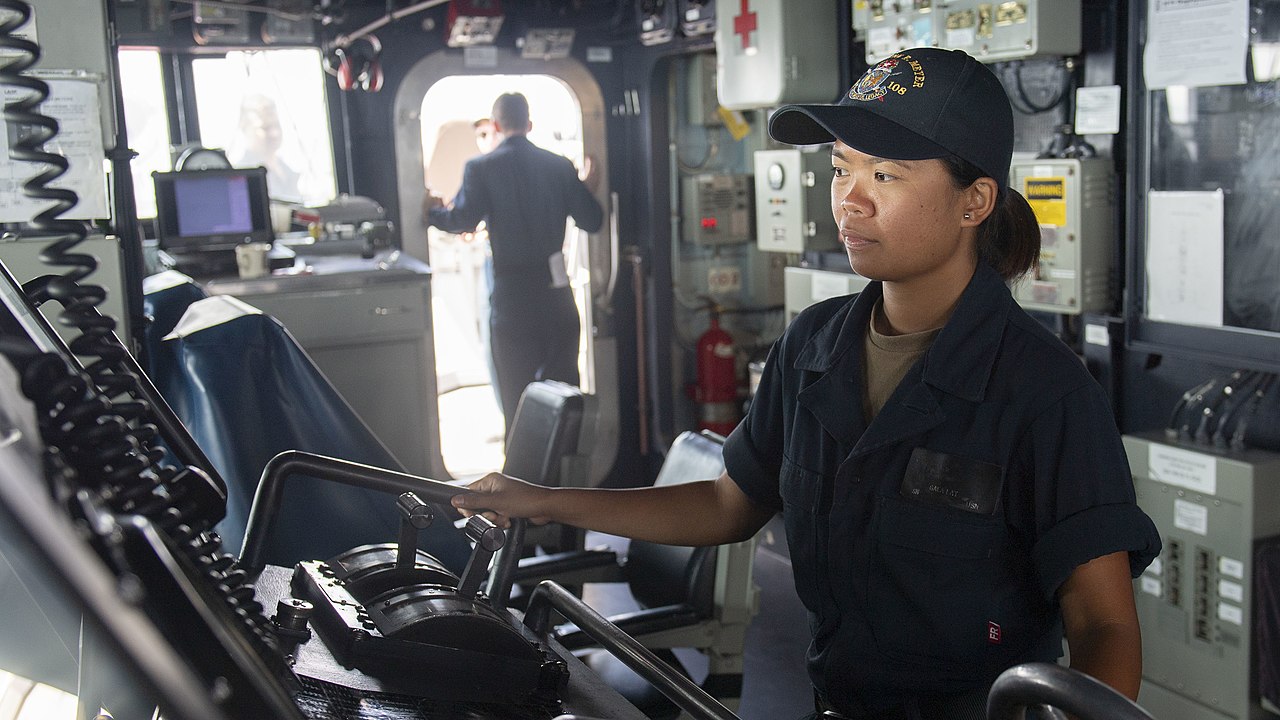A ship at sea is a complex beast, one that needs to be tended at all times. But the crew need to sleep, eat, and even have a little bit of downtime, so a system of watches is used to balance the needs of the ship with those of the crew. The broad system has remained largely intact for centuries, although the details change depending on circumstances. The word watch itself can mean several different things. It's a period of time, a specific duty, and also refers to the group of men who will generally be called to go on watch together.

A bridge watch on the USS Missouri
A day is traditionally divided into six 4-hour watches, starting at 2000 in standard time with the first watch (2000-0000), so called because it was the first watch set at night, when off-duty crew were allowed to sling their hammocks. The next watch was the middle watch, also known as the midwatch (0000-0400). Then comes the morning watch (0400-0800), the forenoon watch (0800-1200) and the afternoon watch (1200-1600). At this point, you'd expect something like "last watch", but in fact, the period from 1600 to 2000 was divided into two "dog watches", first and second.1 This meant that there were an odd number of watches in a day, and meant that one watch (group of men) didn't end up with an unpleasant schedule (midwatch was particularly disliked) long-term.2
On sailing ships, watches served not only for organization, but also as the ship's clock. Each vessel was issued with two hourglasses, one of four hours (for the watch) and one of 30 minutes. Every time that hourglass ran out, the ship's bell was rung a number of times equal to the times that hourglass had run through. So a time might be "three bells in the forenoon watch" (0930) or "six bells in the first watch" (2300). In the days before chronometers, this was about the most accurate way to tell time at sea,3 and it remains a part of the daily routine of modern warships.

The clockwork inside H4, one of the first chronometers
So now that we have that out of the way, how does this work for a typical sailor? Again, this depends greatly on the year and the situation. Working a sailing ship is very manpower-intensive, so most vessels during that era had only two watches,4 often known as port and starboard.5 This didn't necessarily mean that men spent half their time in the rigging. During the night watches, it was common practice for men to be allowed to sleep on deck, so long as they were ready for instant action if the sails needed to be worked. During the day, their off-watch time was often taken up by other duties, so seamen of the time were chronically short on sleep. Some ships ran a three-watch system, but this was thought to lead to sloth, so it was uncommon. Things were slightly different for officers. Each watch would be led by a certain officer, called, unsurprisingly, the Officer of the Watch. The captain almost never stood these, focusing on his administrative duties and being ready to take over command if needed. Otherwise, the lieutenants, the Master, and maybe the senior midshipmen would take turns in effective command of the ship. Usually, at least three men were available, although the Officer of the Watch did have to be alert at all times. And then there were men whose duties didn't require 24/7 coverage, such as the carpenter, the cook, and their mates. These were known as the "idlers", and they worked more or less regular hours.
Today, the same system is broadly intact, although the diversity of jobs means that watch schedules vary a lot more than they used to. Some departments (for instance, engineering) might have only a few watch stations to fill, and lots of routine work that can be done on a more normal schedule, so their sailors may only need to stand one watch a day, although they will have additional work to do during their "off hours". Others like the people who run the CIC are in positions where 24/7 coverage is needed, and will probably be on a 3-section watch. If the department is undermanned, this may even turn into the old "port and starboard" system, with 4-6 hours on and the same off.

A sailor helms the destroyer Wayne E Meyer
The watch is led by the Officer of the Deck (OOD), stationed on the bridge while at sea and responsible as representative of the Captain for the safety and navigation of the ship. All authority and responsibility rests with him. Typically, the OOD is a quite junior officer, often only a Lieutenant or a Lieutenant JG during normal operations, and becoming an OOD is the first goal of any surface warfare officer. He or she is usually backed up on the bridge by a Junior Officer of the Deck, who is training for qualification, and possibly a conning officer, also not yet qualified and charged with actually steering the ship. Two other officers are also vital to the running of the ship. The Engineering Officer of the Watch (EOOW) is in charge of the ship's propulsion system, although the exact relationship between him and the OOD is determined by the Captain. And in situations where the ship faces hostile action, a Tactical Action Officer (TAO) is stationed in the CIC. The TAO is usually senior to the OOD, and is charged with controlling the ship's weapons and reacting to any threats. Even the TAO cannot override the OOD where the ship's safety is concerned, although any disagreement between the two will be reported to the Captain immediately.
In port, the OOD is usually stationed on the quarterdeck, where visitors will come aboard. In concept, his or her duties are the same, with the primary responsibility for keeping the ship safe. This can take many forms, from making sure that fire protections are observed to monitoring landmarks in case the anchor is dragging to making sure that nobody is planning on a repeat of the attack on the Cole.
But all of these are simply for normal operations. Things are quite different in combat, which we'll take a look at next time.
1 Etymologists are still unsure why it's called this. ⇑
2 This isn't to say that there have never been any variants on this scheme. Various navies have used other schedules, but most keep on-duty time to 4 hours or less. ⇑
3 Obviously, this couldn't work long-term because the hourglasses wouldn't be perfectly accurate. Observation of local noon was important for navigation, and it was used to start the afternoon watch, providing a reset from a known source. ⇑
4 Groups of men, not periods of time. ⇑
5 I think this came from which side of the ship they lined up on during inspections. ⇑

Comments
So, will a warship at sea use local time or base time? I imagine base time simplifies organization, but complicates operations - we attack at dawn 4:30PM.
It depends on the ship and the situation. Nuclear submarines will usually just pick a time and stick with it. I think the US subs use GMT, but I could be misremembering. Surface ships try to stay reasonably close to local time, although that doesn't always mean in the same timezone. At Jutland, for instance, the German and British clocks differed by an hour. The discrepancy was greater in the Falklands, because the British stuck to GMT and the Argentinians didn't. I think the difference there was 3 hours, and that's about the most extreme I've heard of in common use. I have some vague memory that the Soviets might have put all their ships on Moscow time, but I'm not sure of that.
"Etymologists are still unsure why it’s called this"
Because they're curtailed of course!
Jack Aubrey had many good qualities, but his wit was not one of them.
I'm pretty sure that was a pun by the good Dr. Maturin.
No, it was from Aubrey (or someone Aubrey borrowed it from) when Marturin asked why they were called the dog watches.
It's from Post Captain:
Dogs,' said the chaplain, who was not one to leave his corner of the table silent long. 'That reminds me of a question I had meant to put to you gentlemen. This short watch that is about to come, or rather these two short watches - why are they called dog watches? Where, heu, heu, is the canine connection?'
'Why,' said Stephen, 'it is because they are curtailed, of course.'
A total blank. Stephen gave a faint inward sigh; but he was used to this. 'Mr Butler, the bottle stands by you,' said Jack. 'Mr Lydgate, allow me to help you to a little of the undercut.'
It was the midshipman who first reacted. He whispered to his neighbour Dashwood, 'He said, cur-tailed: the dogwatch is cur-tailed. Do you twig?'
It was the sort of wretched clench perfectly suited to the company. The spreading merriment, the relish, the thunderous mirth, reached the forecastle, causing amazement and conjecture: Jack leaned back in his chair, wiping the tears from his scarlet face, and cried, 'Oh, it is the best thing - the best thing. Bless you, Stephen - a glass of wine with you.'
Huh. I think it came up again in a later volume out of Jack's mouth, and that's where I remembered it from.
@bean... more than once, perhaps even more than once per book from 2-20.
although on second thought maybe that's the "lesser weevil" quip instead...
I imagine it'll come up in the next installment, but my first expose to "port and starboard" watches was in Red Storm Rising, where the ASW captain that was one of the viewpoint characters noted that his vessel (and the entire convoy) was on "port and starboard" schedule (4 on/4 off) except when the weather was truly execrable (this being the North Atlantic, that was saying something) when they could "slack off" to 4/8.
A few thoughts from my experience on watches and how they deviated from what is above:
The Rotation Hours: never saw the six four-hour block set up. Old salts talked about it from back in the day (especially pre-9/11). Never saw it, though. The "normal" watch hours that I was most familiar with was:
7-12
12-17
17-22
22-02 (the Mid Watch)
02-07 (the Reveille, or Rev Watch)
With Port and Starboard watches going reverting to 00-07, 7-12, 12-17, 17-00.
Bridge watches (at least for officers) were normally on four-section, combat watches tended to be three sections (or worse for the Operations Specialists, who were perpetually on Port and Starboard. Maintenance watches also were usually on P/S, but it usually worked out okay for them.
Port and Starboard wasn't too bad if that's all you had to do (and I saw situations where the ship basically collapsed down to P/S and lived off it for a month or so). It was when you had to do your watches and then continue the rest of your job that life sucked.
Four section was good living. Three section watch was rough; my second ship, I was in CIC and perpetually on three section (at best). Three section sucked because you were perpetually getting about three-four hours of sleep and still expected to do everything else. I cannot emphasize how much it sucked.
On the relationship between the TAO and OOD: boy, this is complicated. Officially, numerous documents affirm that the OOD does not report to the TAO...officially.
BUT
...the TAO does get fired if there's an accident, and the TAO is usually in the ship's documents is also responsible for both safe navigation of the ship and the ship's daily routine. And the TAO is almost always going to be the senior person.
So in practice the TAO is superior to the OOD, even if it's not codified that way as a direct-report relationship. I will caveat that this may well be an AEGIS-ism (I know it's different on carriers, for example).
Aubrey quoted Maturin's "cur-tailed" joke several times in later volumes. I believe he gave Stephen the proper credit for it, whether he wanted it or not.